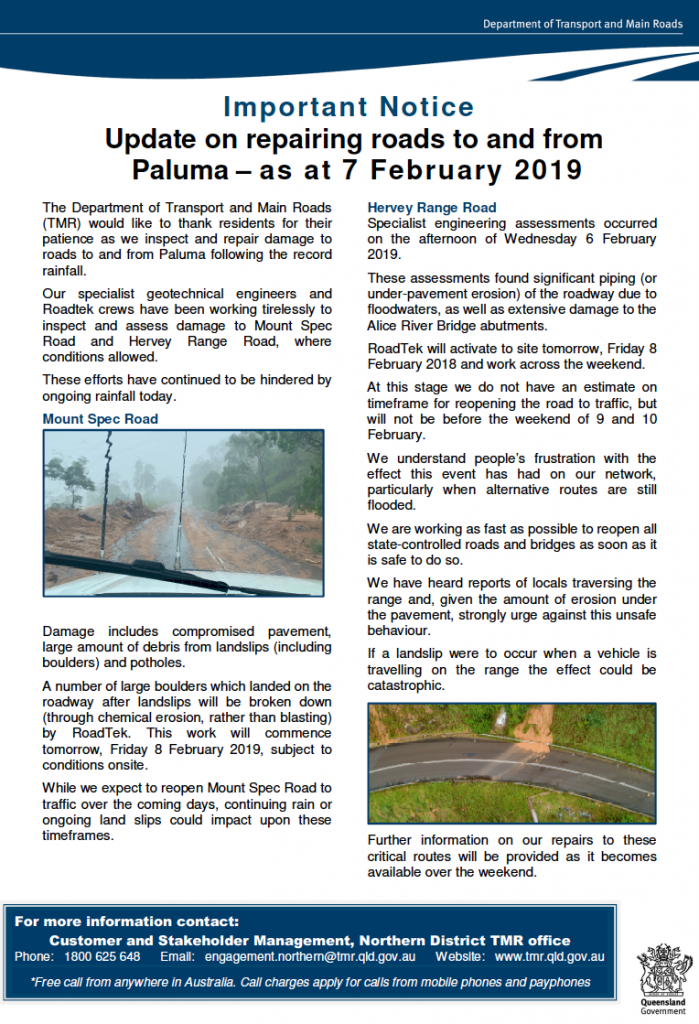
TMR Range Road Update Thursday 7 February


Please be advised that the Department of Transport & Main Roads (TMR) will be providing regular updates on the status of the Range Road via email.
To register for the updates please do one of the following:-
IMPORTANT: In your email, please mention that you want information about Paluma and the Range Road.
Even if you are already registered with TMR on this email address, you MUST RE-REGISTER NOW. This is because TMR are setting up a new and specific email list and dedicated service for Paluma residents regarding the Range Road.
2. As advised by Len Cook today, you can also register by phoning:-
1800 625 648
I have registered to receive information and will also post notices as and when received to this website.
Stay safe everyone!
Michele Bird, Secretary, PDCA
Update Bulletin for Wednesday 6 February 2019
Well, it continues to pour rain here with little prospect of relief until the weekend at soonest, but after seeing the news footage of the catastrophic flooding in Townsville and some surrounding districts, we realise how very lightly Paluma has been affected by this extreme weather event. So far at least, there are no reports here of serious damage to property. Our hearts go out to those whose homes have been flooded and who have lost irreplaceable personal items.
In houses and in the community hall, pools of water lie on some floors, due to leaks in the roof, or ground-water seepage. Where possible, tarpaulins have been used to cover leaky roofs. These inconveniences occur to a greater or lesser degree every wet season; it is just lasting longer this time. A tree fell and smashed the gate at Gumburu and several small trees have fallen in and around the village. The ground is water-logged and rivulets and streams course over the road and down the slopes to join up with Benham’s Creek. Some driveways and sections of the road have been gouged out by the force of water. The official Bureau of Meteorology (BOM) website rainfall readings advise that 2521 mm of rain has fallen since Australia Day (26 January). Len Cook has kindly provided the BOM rainfall figures at the end of this bulletin (below).
Birds are starving and those of us who are feeding them have what seems like an open aviary from dawn to dark with literally scores of birds on the back decks and verandas, seeking food and shelter. Coming to my table are White-cheeked Honey-eaters, Macleay’s and Lewin’s Honey-eaters, Lorikeets, Satin Bower-birds, Cat-birds and Rifle-birds. Hunger overcomes their fear and the birds cling to my arms and shoulders as I fill the feeder trays. Unusually too, there is no fighting for supremacy at the feeder: all species are happy to share.
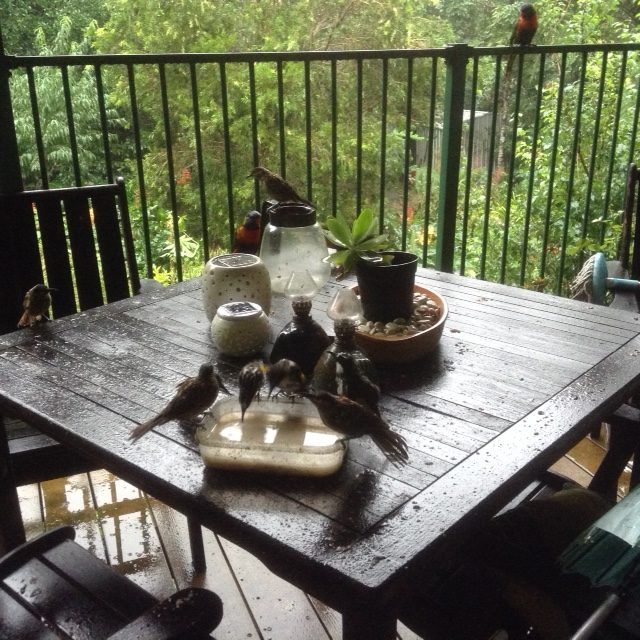
A few days ago the worst crisis was for the several smokers who had run out of cigarettes and/or tobacco. Suggestions that this was a good opportunity to give up smoking, or to roll tea leaves were greeted with disdain. Someone managed to procure tobacco so the situation was saved, temporarily.
Yesterday, some people from the Running River area, armed with shopping lists, ventured to Ingham via the Mt Fox Road. Their return was prevented by a land-slip on the Mt Fox Road.
I am very grateful to the number of absent Paluma residents who have rung, generously offering the contents of their pantries to those of us here, should our food supplies run out. We thank you all so much for your concern and generosity but hope, of course, that things will not drag on to that extent.
As has already been reported, engineers are trying to decide on the best way to remove a huge rock blocking the road about 1.5 km from the village. Two more giant rocks are poised on the up-slope ready to fall and as fast as one slip is cleared, another occurs elsewhere. Conditions are terribly dangerous for those attempting to clear the road, but they are trying to keep a narrow way open for use of emergency vehicles only. Otherwise the road remains closed.
So, we are here for the time being: keeping our sanity by taking long walks in the pouring rain, and getting together for coffee and gossip. Neil Appleton’s birthday offered an excellent opportunity for a very happy such gathering.
Update Bulletin by Colwyn Campbell
BOM Rainfall Figures for Paluma (Courtesy of Len Cook)
Saturday 26 January 2019…………………..93 mm
Sunday 27 January 2019……………………160 mm
Monday 28 January 2019………………….230 mm
Tuesday 29 January 2019………………….370 mm
Wednesday 30 January 2019…………….143 mm
Thursday 31 January 2019………………. 222 mm
Friday 1 February 2019…………………….261 mm
Saturday 2 February 2019……………….303 mm
Sunday 3 February 2019………………….175 mm
Monday 4 February 2019………………..384 mm
Tuesday 5 February 2019………………..180 mm
Total……………………………………………….2521 mm
The village of Paluma remains isolated with the Range Road still closed following the unprecedented rainfall . Locals report today that there are numerous landslides and trees blocking the Range Road and it appears it may be some time before the road will open. Paluma continues to receive astounding rainfall totals.
Don Battersby has been recording rainfall at his place on Hussey Road and has logged the following readings:-
Rainfall overnight (4-5 February 2019) was 344 mm.
Rainfall between 1 to 5 February 2019 is 1294 mm.
Rainfall total for January 2019 is 1206 mm.
Jennie Robinson from the Rainforest Inn reports that there are currently about 23 people in the village and surrounds. Everyone seems to be doing well. The community spirit is certainly alive and well. Yesterday (4 February) was Neil Appleton’s birthday and everyone gathered together at ‘Cloud Cottage’ to celebrate with afternoon tea. Happy Birthday Neil!

Photo courtesy of Jennie Robinson
You will all have seen on the television broadcasts, the widespread flooding around the Townsville – Ingham areas that unprecedented rainfall has caused. Our thoughts and sympathy go to those people in Bluewater and other areas where homes and property have been destroyed or damaged.

How has Paluma fared so far during this extreme weather event?
Paluma residents are used to receiving heavy rains during the Monsoon season but the rainfall over the past few weeks has been exceptionally heavy and unremitting with very heavy falls over the last five days of January. The total for the month was 1208 mm. Many long-term residents say that while heavy rainfall over a period of a few days is not unusual, the duration of this wet weather event is. Nothing like it has been seen for at least 30 years.
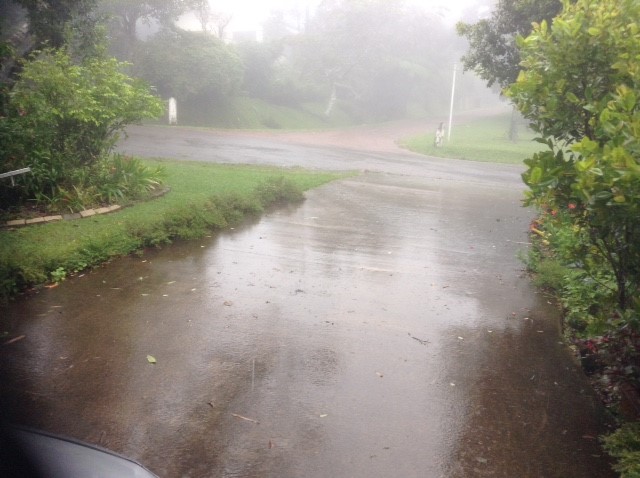
Since Wednesday morning the Range Road has been closed due to fallen trees and land slips. TMR are working at restoring the road but are hampered by the continuing wild weather. Predictions are that we will experience at least another week of wet weather, so it possible that Paluma could remain isolated for several more days. Maybe it is time to launch the Ark from Noah’s Ark Creek.
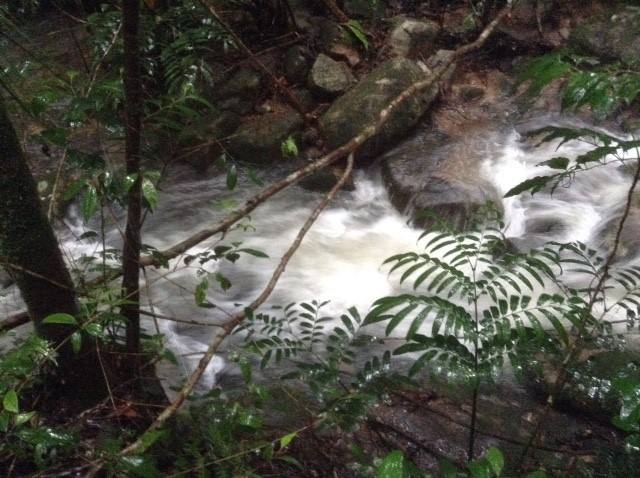
Along the Range Road (when it was still possible to travel to see the sights), the waterfalls were spectacular, the seething water plunging through clefts and grottoes and cascading out and over the road. Twin Falls gushed out like a huge fountain forcing cars through a natural car-wash. Sheets of water hung to rock faces, reflecting light like vast mirrors while rivulets of water coursed across the road. The road surface was littered with leaves and small broken branches. Every so often a very bedraggled brush turkey would make a suicidal dash across the road.
In the village, channels of water rush alongside and over the road, lawns are water-logged, trees have fallen, others hang their limbs low weighed down with the burden of water in their foliage and inconveniently, water has seeped into the lower levels of several houses having forced its way through cracks in brickwork. Birds are ravenous and flock in great numbers to wherever they can find a feed tray; Lorikeets and the smaller honey-eaters happy to share the same dining-room.
It will be time soon, if some have not already done so, to light fires to dry out the houses and our sodden shoes and raincoats.
Text and Photos by Colwyn Campbell
Written on 1st February
A landslide and fallen trees near the top of the Range Road has closed the Paluma Range Road to all traffic. Transport and Main Roads will be working to clear the obstruction today (January 31).
LATEST UPDATE: TMR worked on the road on Thursday but were not able to finish the job. They will continue work on Friday morning, so the road will remain closed for at least part of Friday.
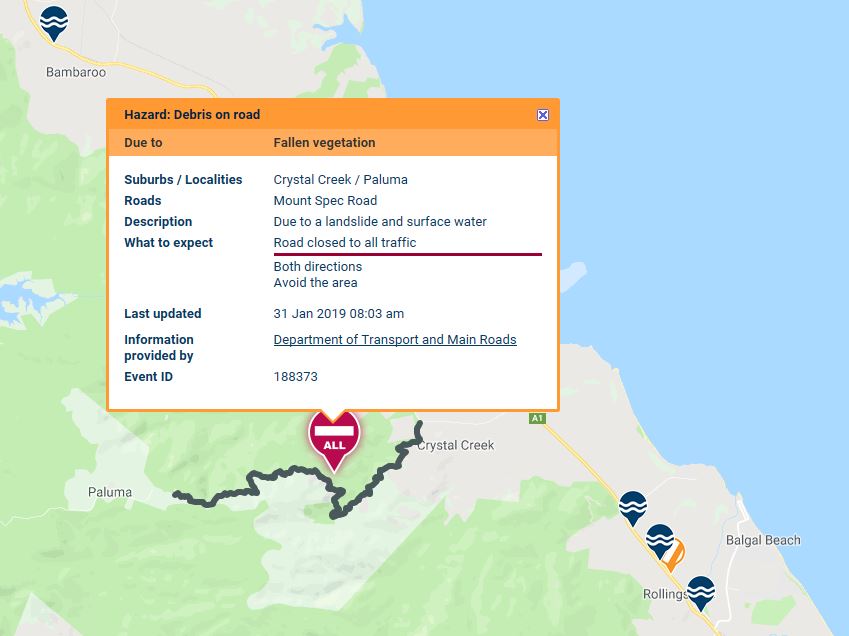
For further updates on the status of the road, visit the TMR website at https://qldtraffic.qld.gov.au/
The Chowchilla (Orthonyx spaldingii) is one of my favourite birds inhabiting the upland rainforest in the Paluma area. It is not a particularly large bird, nor does it have striking plumage. It does not build an elaborate bower like the numerous local bowerbirds and it does not have the impressive dance moves of the riflebird.
BUT, the Chowchilla has a loud and unmistakeable call that echoes throughout the forest, usually at dawn and dusk. Any bird with a call like the Chowchilla demands your attention and admiration. Scientists report that their complex vocalisations vary quite markedly from place to place and there are identifiable local dialects. Imagine that – a unique Paluma Chowchilla language!
Chowchillas are also known as ‘logrunners’. They are ground dwelling birds, living and foraging in small family groups of between 3 to 8 birds. Each flock has their own permanent territory. Chowchillas spend most of their time foraging for invertebrates on the forest floor. They have strong legs for scratching in the leaf litter and their tail is used to support their body whilst they vigorously throw leaf litter aside.
Chowchillas are common in and around the village of Paluma. I see them regularly (or at least flashing glimpses of them) in the forest adjacent to the walking track to McClellands Lookout and along Lennox Crescent. They are regular visitors to the forest margins in my back garden.
I find them absolutely endearing for their elaborate songs and their lively and gregarious nature. When foraging as a family group they happily chatter away, enthusiastically intent on their search for food. They are oblivious that they are excavating precious garden beds and pot plants.
But, I have to admit that Chowchillas are the cause of considerable consternation and ongoing frustration for me!
For about two and a half years I have been trying to ‘capture’ a half decent photograph of a Chowchilla. Dozens and dozens of attempts and not one decent photograph!. Blurry, dark and unfocused images of Chowchillas are my speciality!
If I manage to find a bird within photographic range, it will rarely sit still for more than a split second and will surely move just at that moment when I press the shutter. Because the birds inhabit the forest floor, the light is usually poor and it is hard to see the bird clearly, let alone focus the camera.
I am well aware my frustration is shared by many fellow birdwatchers and photographers. ‘Photographing a Chowchilla’ is high on the wish list of many bird enthusiasts who visit Paluma, but it seems not many people actually achieve their goal.
So, after two and a half (long) years, this is my best effort at a Chowchilla photograph. Blurry, too dark, not centred and the bird is obscured by vegetation. And I am sure that Chowchilla is grinning at me, just before it darts back into the cover of the rainforest foliage. I’ll keep trying……….!
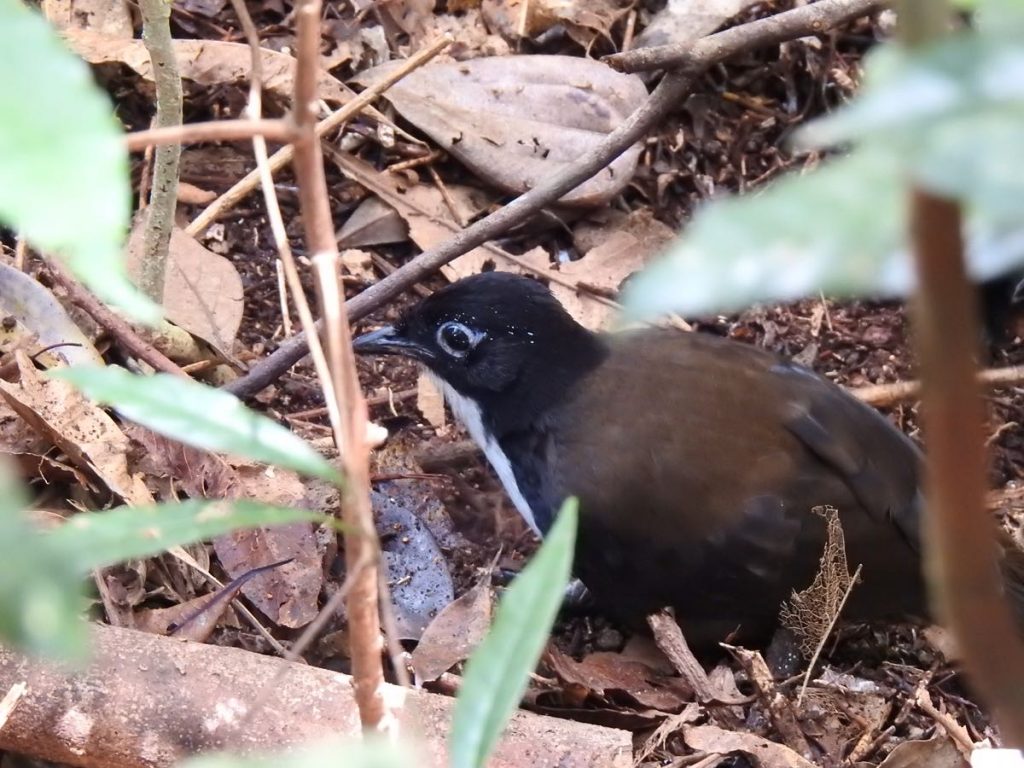
Please let me know if you have had better success in capturing images of these beautiful, but very elusive birds in and around the Paluma area!
Text & (Blurry) Photo by Michele Bird
QUANDONG
Elaeocarpus grandis, synonymous with Elaeocarpus angustifolius
Most of you will be familiar with the Quandong’s moss-covered buttressed roots projecting out from the forest onto the edges of walking tracks. Many of these magnificent trees may be seen in the Paluma rainforest with some especially good specimens along the Witt’s Lookout track. The Quandong, a tree emblematic of tropical rainforest is also known as Blue Quandong, Silver Quandong, Blueberry Ash and Blueberry Fig.

A pioneering tree, the Quandong can grow to five or six metres high in just a few years, eventually reaching a height of up to 35 metres. A strong identifying feature are the buttresses with vertically flat, visible roots, so large in some instances that they are capable of sheltering a cassowary. Moss usually covers the trunk and roots so it is difficult to readily see the nature of the bark, but the cut timber is hard and white and highly regarded as a cabinet timber.

Flowering occurs between October and March, the softly fragranced flowers, growing in racemes from axils or on branches are usually high in the tree and difficult to see. They can be green, white or cream with tiny petals about 5 mm long.
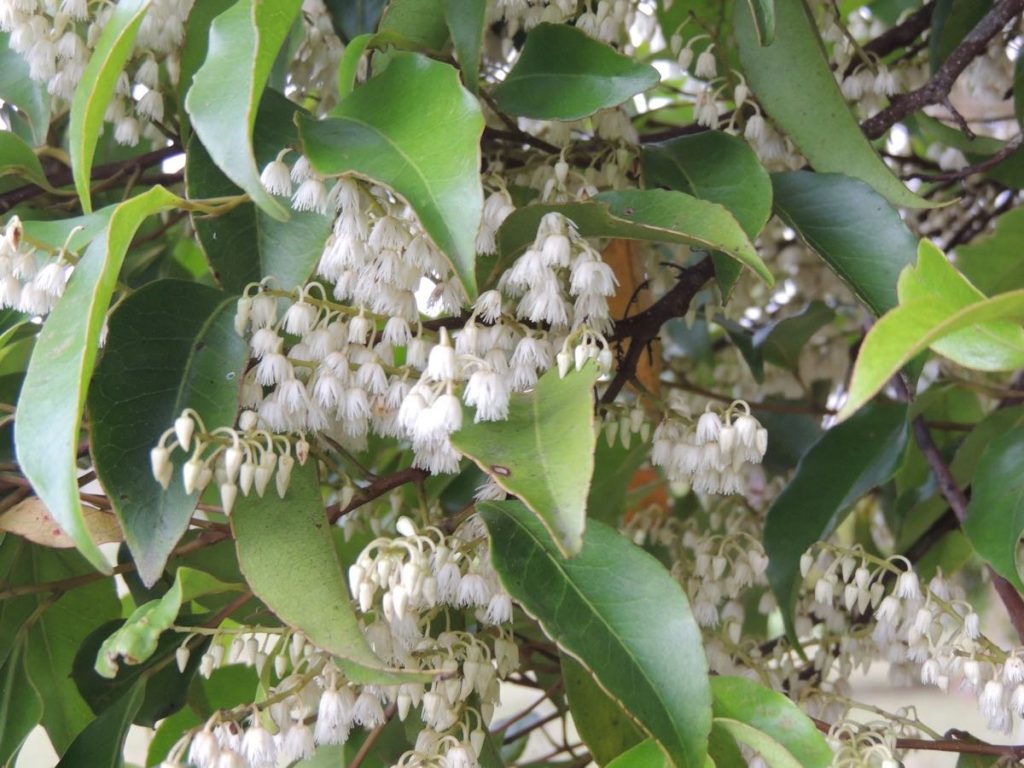
Fruiting can occur at any month. You can sometimes find the blue to purple fruit lying among the fallen leaves on the rainforest tracks. Their colour is often enhanced with a metallic sheen. The fruit is a drupe (fleshy with one or more seeds inside) and can be anything from the size of a small grape to that of a golf ball. The fruit is edible and has a higher Vitamin C content than oranges. It is best eaten when slightly over-ripe or it can taste bitter. It can be used in jams or pickles. Many bird species eat the fruit which is also eaten by Bush Rats, Spectacled Flying Foxes and Musky Rat Kangaroos.
The leaves of the Quandong are glossy and about 80 to 150 mm long. As it ages the leaf turns a bright red before dropping. Many can be seen at any time along the walking tracks.
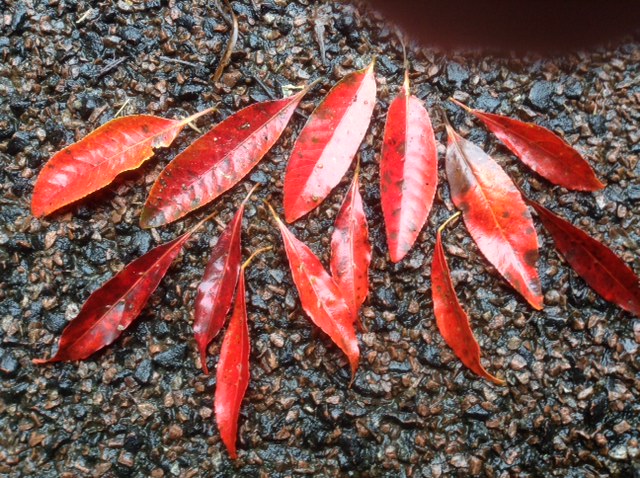
The Quandong was highly valued by rainforest Aboriginal people. The fruit was recognised for its medicinal properties and as a food source. They would also make an edible paste from the ripe fruit. Shields were made from the large buttress roots.
Look for these spectacular trees next time you take a walk along one of the rainforest tracks.
Text & Photos by Colwyn Campbell
On New Year’s morning, there were a few million animals hanging out together on a decaying log on the forest floor on ‘H Track’, doing their thing. This is a Slime Mould, and most likely to be Physarum polycephalum, the Many Headed Slime Mould, and some of the things they do are quite funky.
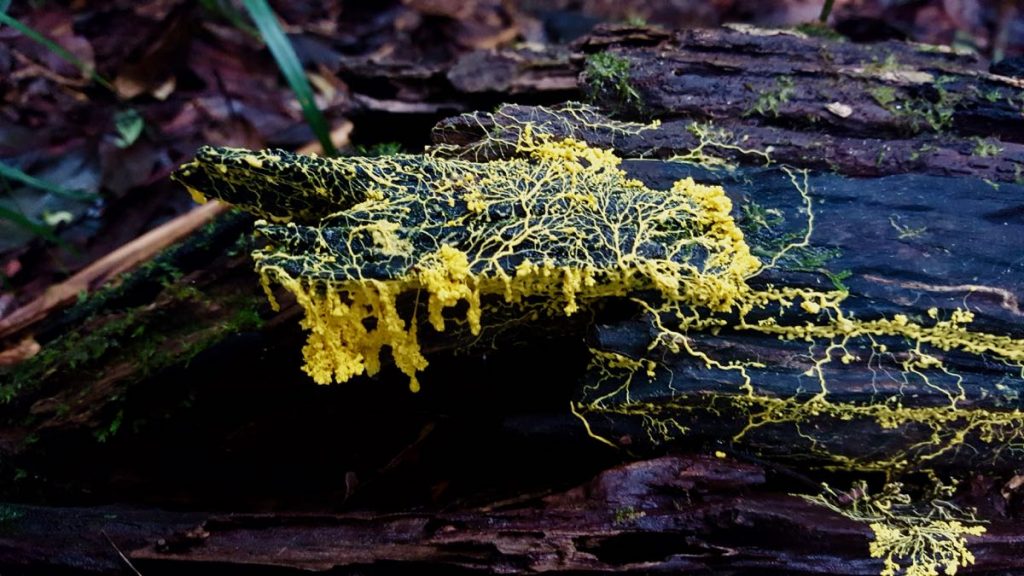
Slime moulds are thought to be approximately 600 million years old, although some think they could be as old as a billion. They arrived on land as soon as there was land, making them hundreds of millions of years older than other animals or plants. So, okay, they have been around for a long time, but what are they?
Slime moulds are Protists, or single celled organisms, which like moist, humid, dark environments, such as the rainforest floor. They favour rotting and decaying vegetation, where they feed on micro-organisms, including fungi, algae and bacteria. A single slime mould cell, in favourable conditions exists as an Amoeba, basically a nucleous surrounded by cell fluid, contained within a membrane. Amoeba travel by moving this fluid within the flexible cell membrane in a process known as cytoplasmic streaming, which is handy when you need to hunt down your prey, before engulfing it with your body. But what about when food is scarce, and too difficult to find when you’re a microscopic bag of fluid?
Slime moulds form a plasmodium, which is the part of the life cycle shown in the photo. Huge numbers of single celled amoebae find each other in the environment using chemical signals, and join together, losing individual cell membranes to form a complex organism. This organism is also able to move to search for food, which it surrounds, before secreting enzymes to digest it. This is also the primary reproductive stage for slime moulds; if food runs out, conditions become too dry or receive too much light, the plasmodium begins to make spores. This is the stage the photographs show, with the bumpy bits (the many heads of our slime mould) containing the spores.
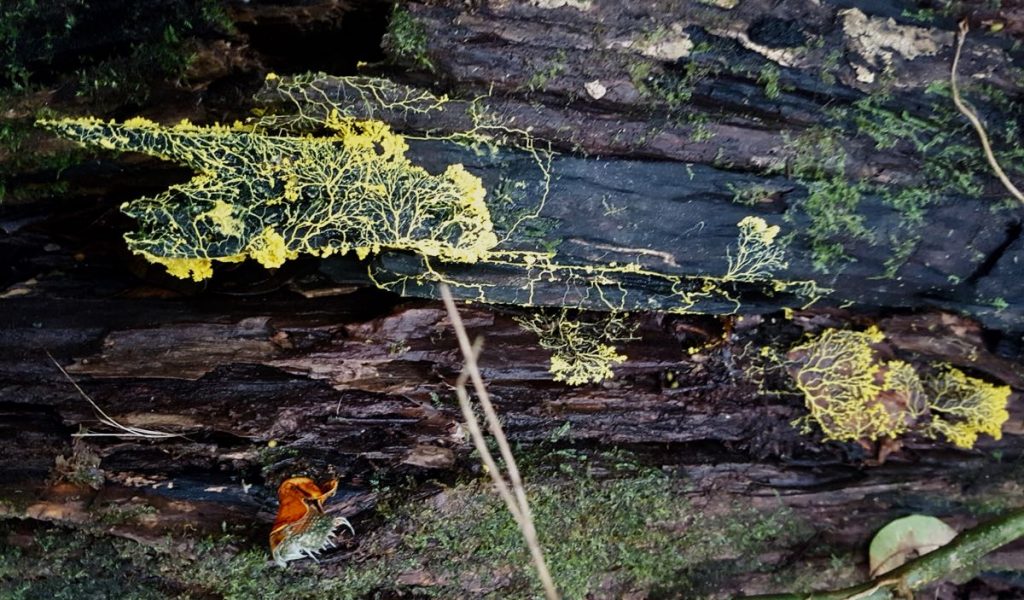
The spores are able to survive unfavourable environmental conditions for long periods of time. When conditions improve, the spores rupture, producing a single cell amoeba. However, if things get too wet, this amoeba is able to rapidly transform into a flagellated organism (a flagellum is a long, whip-like structure which helps the animal move in water, similar to swimming). This shape is also reversible when conditions are not quite so wet, and being an amoeba is more convenient.
But you don’t get to be nearly a billion years old without having a few more tricks up your sleeve. If life becomes uncomfortable at the plasmodium stage, the organism can become dormant, and it can survive like this for many years. Amoeba can also transform into cysts to survive when conditions are unfavourable. It’s kind of like being able to go into suspended animation whenever it’s too hot, too dry or too bright. Amoeba can also fuse with other single amoeba to form a reproductive organism, or a single amoeba can reproduce by just splitting. Plasmodia can also fragment or enter another dormant phase called a spherule which can survive indefinitely. So, Slime Moulds have lots of options, including shape shifting, mind (and body) melding and suspended animation to enable them to survive in this unpredictable and changeable world. And that’s why they’ve been around so long!
These amazing creatures have fascinated scientists, and provided many opportunities for research. They are easy to culture in laboratories, and provide a model organism to study amoeboid movement, cell motility, and other anatomical and physiological processes. The real surprise however is that slime moulds also provide opportunity for behavioural research. They have been observed finding food in mazes and forming networks between food sources to provide efficient nutrient transport that rivals our own transport design systems. These adaptable and resilient organisms will probably be around for the next billion years!
Text & Photos by Sarah Swan
It is with great sadness that the PDCA Executive Committee posts the following notice as received from James Jackson today (21 January 2019).
RE: The Passing of John Tubman
As most would know, John has been fighting an aggressive form of cancer for over two years. He was admitted to TGH early last week (14th) with complications arising from the condition and despite intense treatment and care failed to recover.
John passed away about 11.00 am on Friday 18th with family by his side. It will take quite some time for Junita and John’s siblings and family to reach acceptance of his passing, but all have been buoyed by, and are very grateful for the kind words, thoughts and condolences offered from many of John’s friends and colleagues.
A service for John will be held at Morley’s Funeral Home commencing at 1.00pm this Friday January 25th. Notice to appear in Townsville Bulletin on Wednesday 23rd.
On behalf of Junita and John’s Family, I would like to convey their appreciation for your kind messages and thoughts of sympathy.
James Jackson